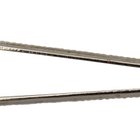
IPGGutenbergUKLtd/iStock/Getty Images
After a hysterectomy, some women experience a surge in growth of facial and body hair, particularly if the ovaries were removed along with the uterus. The condition, known as hirsutism, occurs when there is an imbalance between the amount of androgens, or male hormones, and estrogen in the blood system. Additionally, some postoperative women are treated with hormone replacement therapy to ease the discomfort of other hysterectomy side effects, such as fatigue, low libido or vaginal dryness. This treatment can also cause an increase in unwanted hair. While hirsutism is not harmful, many women who experience the condition feel self-conscious about their appearance. However, several treatment options are available.
Use a depilatory to remove unwanted hair. The chemicals in a depilatory break down the hairs so they can be easily wiped away with a tissue or towel. Follow the manufacturer's instructions closely and avoid leaving the product on longer than recommended, because skin irritation can occur.
Talk to your doctor about pharmaceutical treatment options. Anti-androgen medications such as Spironolactone and Finasteride can cause unwanted hair to grow in finer and less noticeable over time. Additionally, the FDA-approved prescription cream Vaniqa, applied twice daily, slows hair growth at the root. With continued use, most women see an improvement within three to six months.
Consult with a professional electrologist for permanent removal of excess hair. After applying a topical anesthetic to the treatment area, an electrologist uses a tiny needle to deliver an electrical charge to each individual follicle. The hair can then be easily removed with tweezers. Several treatments over weeks or months may be necessary for optimal results.
Consider laser hair removal for the treatment of hirsutism. A laser treats multiple follicles at a time with a high energy beam of light that is absorbed by the pigment of each hair. Because of this, however, laser treatments are not recommended for darker skin tones since the surrounding skin can also absorb the light beams. This may result in pigment changes to the skin. Laser treatments work best on those with light skin and dark hair. Additionally, since hair growth is cyclical, during and after laser treatment, use a broad spectrum sunscreen with an SPF of 30 or higher when outdoors. The American Academy of Dermatology recommends three or more treatments for a permanent reduction of unwanted hair.
Related Articles

Photofacial Vs. Microdermabrasion

Home Remedies to Permanently Remove ...

What Are the Causes of Hair Shedding in ...

Chemicals That Stop Testosterone ...

Women With Facial Hair Shaving Vs. ...

Can Drinking Nettle Tea Reduce DHT ...

How to Remove Hair Stuck in Hair Curlers

Fraxel Repair Vs. Restore Results

Treatment of Razor Bumps for Black Women

How to Stop a Mustache From Growing for ...

How to Get Rid of Stomach Hair ...

Negative Effects of Endermologie

How to Remove Hair Follicles to Prevent ...

How Does Menopause Affect a ...

What Are the Dangers of Fraxel Repair?

How to Stop Facial Hair Growth for Men

How to Remove an Eyebrow Tattoo

Laser Treatment for Face Wrinkles

How to Fix an Irritated Upper Lip After ...

Fraxel Laser Treatment Dangers
References
Writer Bio
Based in Los Angeles, Claire McAdams has been writing professionally since 2006. Her work has appeared in "The Tennessean" and also online at MaestroCompany.com and SoCal.com. She holds a Bachelor of Music Degree from Belmont University and a Bachelor of Arts Degree in History and Political Science from King College.
Photo Credits
IPGGutenbergUKLtd/iStock/Getty Images